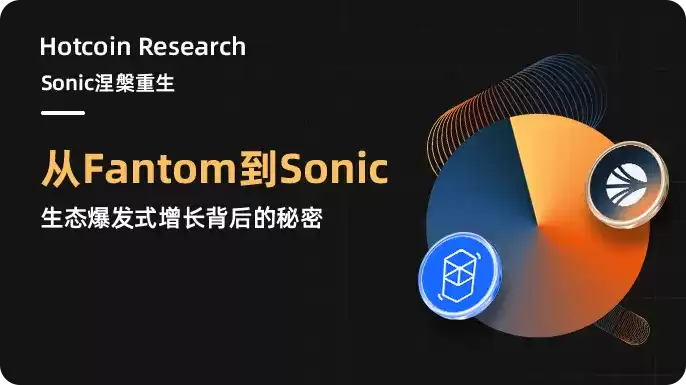 |
|
 |
|
 |
|
 |
|
 |
|
 |
|
 |
|
 |
|
 |
|
 |
|
 |
|
 |
|
 |
|
 |
|
 |
|
自Fantom升级到Sonic以来,链上TVL和令牌已经显示出爆炸性的增长趋势。

Introduction
介绍
Since Fantom upgraded to Sonic and announced a series of new plans, both the on-chain TVL and tokens have shown explosive growth trends. The introduction of the new FVM virtual machine, Carmen storage system, and Sonic Gateway has brought continuous development momentum to the ecosystem. Moreover, the return of Andre Cronje and his influence in the DeFi field help attract quality projects to join Sonic and promote a positive cycle of the Sonic ecosystem through his four visions (fee monetization, transaction fee subsidies, dynamic fees, and native economic account abstraction). The upgrade from Fantom to Sonic marks a rebirth for this veteran public chain, making Sonic one of the fastest-growing emerging chains. As long as the ecosystem's popularity and capital inflow are maintained, Sonic's TVL is expected to further increase, potentially challenging the locked asset scale of traditional mainstream public chains. This article will delve into the key data and driving factors behind the growth of the Sonic ecosystem, focusing on its technological upgrades, popular projects, and token market performance, and explore the new trends and investment opportunities in DeFi that Sonic may lead in the future.
自Fantom升级到Sonic并宣布了一系列新计划以来,链上TVL和令牌都显示出爆炸性的增长趋势。新的FVM虚拟机,Carmen Storage System和Sonic Gateway的引入为生态系统带来了连续的开发动力。此外,安德烈·克朗耶(Andre Cronje)的归来及其在defi领域的影响力有助于吸引高质量的项目加入Sonic,并通过他的四种愿景(费用货币化,交易费用补贴,动态费用和本地经济账户抽象)来促进声音生态系统的积极周期。从Fantom到Sonic的升级标志着这位资深公共连锁店的重生,使Sonic成为增长最快的新兴连锁店之一。只要维持生态系统的知名度和资本流入,Sonic的TVL就会进一步增加,这可能会挑战传统主流公共连锁店的锁定资产规模。本文将深入研究声音生态系统增长的关键数据和驱动因素,重点关注其技术升级,受欢迎的项目和代币市场绩效,并探索Sonic在未来可能会导致的Defi的新趋势和投资机会。
Changes from Fantom to Sonic Upgrade
从Fantom到声音升级的变化
The renaming and upgrading of Fantom to Sonic is not just a change of name, but also represents significant improvements in the underlying architecture. The core of this upgrade includes the Fantom Virtual Machine (FVM), storage system optimization (codenamed Carmen), and the Sonic Gateway cross-chain gateway. These upgrades aim to comprehensively enhance network performance, scalability, and interoperability, providing a better experience for developers and users.
Fantom对Sonic的重命名和升级不仅是名称的更改,而且代表了基础架构的重大改进。此升级的核心包括Fantom Virtual Machine(FVM),存储系统优化(代号Carmen)和Sonic Gateway跨链网关。这些升级旨在全面增强网络性能,可扩展性和互操作性,为开发人员和用户提供更好的体验。
1. Technical Upgrade Content
1。技术升级内容
1) Fantom Virtual Machine (FVM): Sonic introduces its self-developed FVM to replace the original EVM execution environment. FVM is fully compatible with EVM, allowing existing Ethereum contracts to be seamlessly migrated to Sonic, reducing development and migration costs. More importantly, FVM has been deeply optimized for parallel processing and instruction sets, with its smart contract execution speed and throughput improved several times compared to EVM. Test results show that FVM improves transaction processing speed by 8.1 times and reduces on-chain data storage requirements by 98%. This means that on Sonic, transaction confirmations can be completed in sub-second levels, with users hardly feeling any delay; at the same time, network resource utilization is higher, consuming less computational and storage resources per transaction. For developers, FVM provides more comprehensive debugging tools and supports more programming languages beyond Solidity and Vyper, giving developers more flexibility. In summary, FVM greatly alleviates the performance bottlenecks of the previous EVM, providing a fertile ground for complex DApps on Sonic. 2) Carmen Storage System Optimization: As the blockchain runs over time, the explosive growth of state data can place a heavy burden on nodes. To address this, Sonic has adopted a brand new Carmen state database. This solution can trim and compress historical data on demand, significantly reducing the storage requirements for nodes. After the upgrade, the amount of data required to run a validating node has decreased from about 2000GB to 300GB; the storage requirements for a full archival node have dropped from over 11TB to less than 1TB. The drastic reduction in storage burden lowers the operational costs for nodes, enabling more ordinary participants to run nodes, thereby increasing the network's decentralization and security. At the same time, Carmen supports parallel processing of data requests, maintaining efficient responses even under high loads. For frequently accessed data (such as DeFi protocol states), the system employs intelligent strategies to ensure fast reading, while older and less frequently used data is compressed and archived. All of this ensures that the Sonic network can maintain performance and scalability at a low cost even in large-grade application scenarios. 3) Sonic Gateway Cross-Chain Gateway: To enhance interoperability with ecosystems like Ethereum, Sonic has launched the native cross-chain bridge Sonic Gateway. It is a decentralized bridging solution that connects the Ethereum mainnet and the Sonic network, enabling secure two-way cross-chain asset transfers. Through Sonic Gateway, users can quickly transfer ERC-20 assets from Ethereum to Sonic (arriving in about 10 minutes), while transferring back from Sonic to Ethereum takes about 1 hour. The bridge has a comprehensive security mechanism, such as built-in fault protection: if the gateway is unusable for 14 consecutive days, users can retrieve their original assets on the Ethereum side, eliminating the risk of assets being locked for long periods. Additionally, the gateway monitors the status of both ends through cross-chain "heartbeat" signals to ensure the safety of user funds. Compared to typical Ethereum Layer 2 solutions, Sonic's cross-chain transfers do not require a 7-day challenge period. It is worth mentioning that while Sonic is highly integrated with Ethereum, it is not a Layer 2 expansion but a hybrid L1+L2 network: from Ethereum's perspective, Sonic connects to the mainnet like an L2, but it remains an independent L1,
1)Fantom Virtual Machine(FVM):Sonic引入了其自发开发的FVM,以替换原始的EVM执行环境。 FVM与EVM完全兼容,可以将现有的以太坊合同无缝迁移到Sonic,降低发展和迁移成本。更重要的是,与EVM相比,FVM已针对并行处理和指令集进行了深入优化,其智能合同的执行速度和吞吐量几倍。测试结果表明,FVM将交易处理速度提高了8.1倍,并将链上数据存储要求降低98%。这意味着,在声音上,交易确认可以以次秒级别完成,用户几乎没有任何延迟。同时,网络资源利用率更高,每笔交易消耗较少的计算和存储资源。对于开发人员而言,FVM提供了更全面的调试工具,并支持超越坚固和刺激的更多编程语言,从而使开发人员更加灵活。总而言之,FVM极大地减轻了以前EVM的性能瓶颈,为Sonic的复杂DAPP提供了肥沃的基础。 2)卡门存储系统优化:随着区块链的运行,状态数据的爆炸性增长可能会给节点带来沉重的负担。为了解决这个问题,Sonic采用了全新的Carmen State数据库。该解决方案可以根据需求进行修剪和压缩历史数据,从而大大减少节点的存储要求。升级后,运行验证节点所需的数据量已从约2000GB减少到300GB。完整档案节点的存储要求已从11TB以上降至小于1TB。存储负担的急剧减少降低了节点的运营成本,使更多的普通参与者能够运行节点,从而增加了网络的权力下放和安全性。同时,卡门支持并行处理数据请求,即使在高负载下也保持有效的响应。对于经常访问的数据(例如DEFI协议状态),该系统采用智能策略来确保快速阅读,而较旧且较少使用的数据被压缩和存档。所有这些都确保了Sonic网络即使在大型应用程序方案中也可以以低成本保持性能和可伸缩性。 3)声道网关跨链门户:为了增强与以太坊这样的生态系统的互操作性,Sonic启动了本地跨链Sonic Gateway。它是一种分散的桥接解决方案,它连接以太坊主网和声音网络,可实现安全的双向跨链资产转移。通过Sonic Gateway,用户可以快速将ERC-20资产从以太坊转移到Sonic(大约10分钟内到达),同时从Sonic转移到以太坊大约需要1小时。该桥具有全面的安全机制,例如内置故障保护:如果连续14天无法使用该网关,则用户可以在以太坊一侧检索其原始资产,从而消除了长期锁定资产的风险。此外,网关通过交叉链“心跳”信号来监视两者的状态,以确保用户资金的安全。与典型的以太坊2层解决方案相比,Sonic的跨链转移不需要7天的挑战期。值得一提的是,尽管Sonic与以太坊高度融合,但它不是第2层的扩展,而是混合L1+L2网络:从以太坊的角度来看,Sonic像L2一样连接到了Mainnet,但它仍然是独立的L1,它仍然是一个独立的L1,
免责声明:info@kdj.com
所提供的信息并非交易建议。根据本文提供的信息进行的任何投资,kdj.com不承担任何责任。加密货币具有高波动性,强烈建议您深入研究后,谨慎投资!
如您认为本网站上使用的内容侵犯了您的版权,请立即联系我们(info@kdj.com),我们将及时删除。
-

- 市场不想现在上升。只是害怕上升。它正在等待新闻。
- 2025-04-14 09:10:13
- 市场不想现在上升。只是害怕上升。它正在等待新闻 - 无论是数据还是要查看特朗普接下来会做什么。在过去的24小时中,
-

-

- 总部位于美国的现货比特币ETF将负面流失条纹扩展到7天
- 2025-04-14 09:05:12
- 由于持续的贸易战,美国投资者似乎正在远离数字资产和基于加密货币的金融产品等风险资产。
-

-

-

- TrollerCat($ TCAT)在模因硬币市场中脱颖而出
- 2025-04-14 09:00:13
- 您是否注意到了加密货币世界中模因硬币的迅速崛起?最初的在线笑话很快发展成为有利可图的投资机会
-

- 不要从场边看这个
- 2025-04-14 08:55:12
- 这就是人们现在对人们的想法的一种问题,因为Binance Coin(BNB)的价格在$ 577中弹起,而Bulls则注视着600美元的突破
-

- Qubetics($ TICS):加密货币的下一个大机会
- 2025-04-14 08:55:12
- 本月,聚光灯放在几个加密项目上,有可能提供令人印象深刻的回报。但是在噪音中,有一个项目在波浪
-

- 加密崩溃在24小时内将市场下跌了3%
- 2025-04-14 08:50:14
- 本周在加密货币市场上开始了粗糙,仅一天就下降了3%。当交易者争先恐后地重新评估其头寸时,红色占据了图表的主导地位。




























































